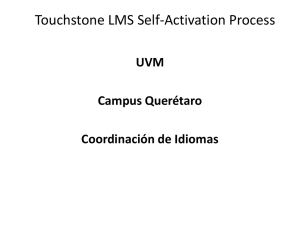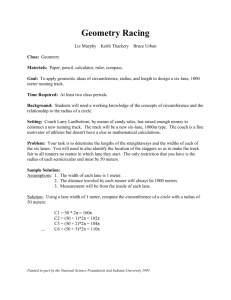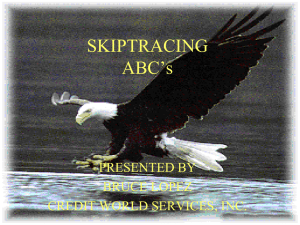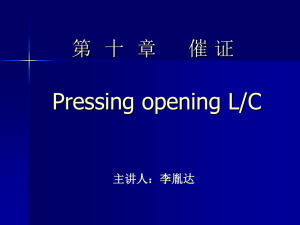Final Inspection Report
advertisement
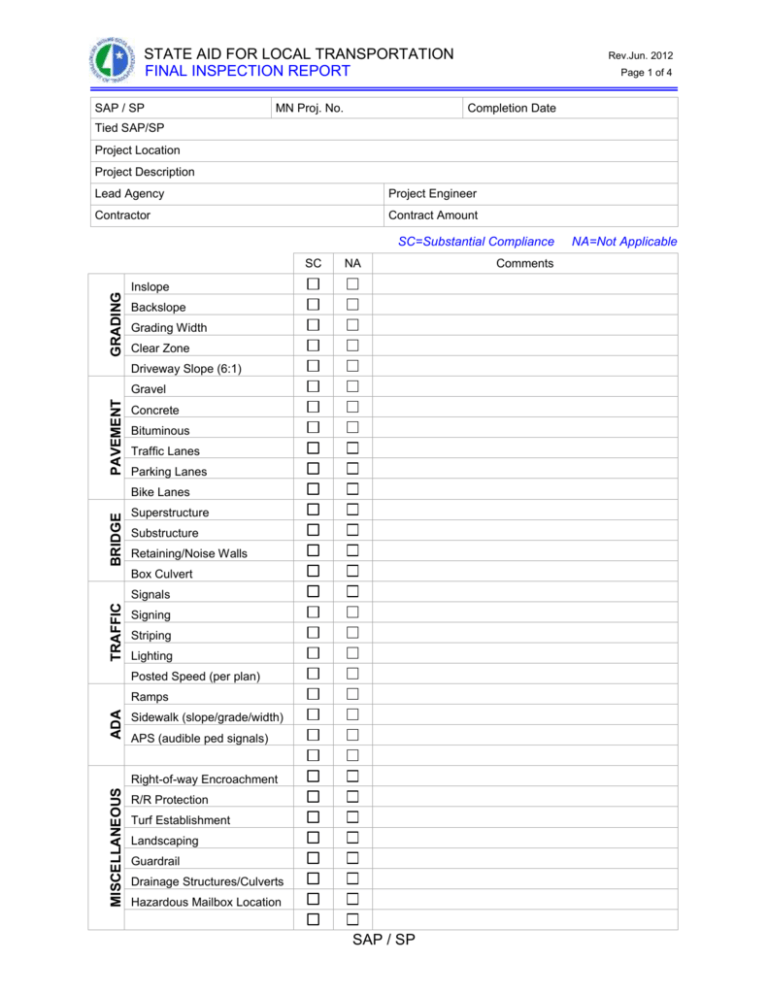
STATE AID FOR LOCAL TRANSPORTATION FINAL INSPECTION REPORT SAP / SP MN Proj. No. Rev.Jun. 2012 Page 1 of 4 Completion Date Tied SAP/SP Project Location Project Description Lead Agency Project Engineer Contractor Contract Amount SC=Substantial Compliance GRADING SC NA Inslope Backslope Grading Width Clear Zone Driveway Slope (6:1) PAVEMENT Gravel Concrete Bituminous Traffic Lanes Parking Lanes BRIDGE Bike Lanes Superstructure Substructure Retaining/Noise Walls Box Culvert TRAFFIC Signals Signing Striping Lighting Posted Speed (per plan) ADA Ramps Sidewalk (slope/grade/width) APS (audible ped signals) MISCELLANEOUS Right-of-way Encroachment R/R Protection Turf Establishment Landscaping Guardrail Drainage Structures/Culverts Hazardous Mailbox Location SAP / SP Comments NA=Not Applicable STATE AID FOR LOCAL TRANSPORTATION FINAL INSPECTION REPORT Rev.Jun. 2012 Page 2 of 4 Remarks Final Inspection by: ____________________________________________ District State Aid Engineer Final Inspection Noted Discrepancies Needing to be Resolved: Yes / No Corrective Actions Taken by Project Engineer: Signature of Project Engineer required if discrepancies noted above: ___________________________________________ Project Engineer SAP / SP _________________ Date ____________ Date STATE AID FOR LOCAL TRANSPORTATION FINAL INSPECTION REPORT Rev.Apr. 2012 Page 3 of 4 Helpful Hints: Grading: Inslope – check the inslope and ditch width for compliance with Project Documents Backslope – check the backslope and ditch width for compliance with Project Documents Grading Width – check the edge of shoulder to edge of shoulder (P.I. to P.I.) dimensions, verify compliance with Project Documents. For projects left as a gravel road, verify that the proper road width will be achieved once the paving surface and shoulders have been placed. Clear Zone – verify that proper clear zone distances are present. Look for hazardous obstructions or guardrail when clear zones are not met Driveway Slope – verify that inslopes of intersecting driveways are at the appropriate grade Pavement: Concrete – check for surface defects, proper cross slope, joint spacing, joint sealant, surface texture, match points at project termini locations, etc. Bituminous – check for surface defects, rutting, raveling, proper cross section width, ride quality if applicable, match points at project termini locations, proper cross slope, etc. Traffic Lanes – verify lane width complies with Project Documents. For urban settings, note any issues with utility structures being located in the wheel path (more of a design flaw, but should be discussed with engineer for future projects) Parking Lanes – verify parking lane width and type (parallel or diagonal) complies with Project Documents Bike Lanes – verify lane width and location. Note any potential safety hazards. Bridge: Superstructure – check for issues on bridge deck, expansion joints, railings, guardrails at ends of bridge, approach panels. Also verify bridge dimensions (overall width, traffic lane width, curb reaction distances, etc.) comply with Project Documents. Substructure – check for issues with piers, pier caps, beams/girders, bridge abutments, scour treatments (rip rap placement, etc.), under bridge lighting, etc. Retaining/Noise Walls – check retaining walls and noise walls for proper location and apparent defects or problems. Box Culverts – verify proper size, scour treatment (rip rap), backfill compaction issues (sinkholes, etc.), washouts, proper grout/backfill between adjacent box culvert structures, guard rail and railing placement as required, etc. Traffic: Signals – check traffic signal systems for proper operation, signal head location (alignment with driving lanes) and orientation, pedestrian signal actuator locations/operation, material defects (holidays in the paint, exposed cable wiring), drainage issues around electrical hand holes that may cause flooding in structure and possible damage to signal system, etc. Signing – check for proper sign location and installation, damaged signs, etc. Striping – check for proper stripe spacing (lane widths), tapers, stripe color, reflective material installation (glass beads, etc.), proper crosswalk and stop bar location, recessed or ground-in striping as required, etc. Lighting – check lighting system for proper operation, check for burnt out luminaires, drainage issues around lighting control cabinets and hand holes that may cause flooding and damage to lighting system, exposed cable or wiring, proper light pole setbacks from edge driving lane, damage to materials (holidays in the paint, cracks or damage to light pole, etc.) Posted Speed (per plan) – verify the proper speed limit is posted per the cover sheet of the Project Plan ADA Ramps – check for proper dimensions, grade, and orientation, check for apparent pedestrian hazards SAP / SP STATE AID FOR LOCAL TRANSPORTATION FINAL INSPECTION REPORT Rev.Apr. 2012 Page 4 of 4 Sidewalk (slope/grade/width) – check for proper dimensions, grade, and orientation, check for apparent pedestrian hazards. APS (audible pedestrian signals) – check to make sure the APS is placed in the proper location and orientation for visual or hearing impaired individuals, verify the APS is operational and doesn’t create a confusing situation by being located to close to another APS which may cause issues for persons with visual and hearing impairments. Miscellaneous Right-of-Way Encroachment – look for any structures that may be improperly located in or out of the highway R.O.W. R/R Protection – verify that the required warning device is installed and operational at each railroad crossing. Turf Establishment – verify all turf has been established, look for washouts or drainage issues, verify that all temporary erosion control devices have been removed (silt fence, silt logs, catch basin baskets, etc.) Landscaping – make note of any landscaping treatments that have died or been damaged and need to be replaced. Guardrail – check for proper guardrail installation (height, setback from edge of traffic lane, type, etc.); look for any apparent damage or defects that need to be replaced. Drainage Structures/Culverts – check for issues with drainage structures (catch basin settlements, incorrect castings, etc.), washouts, rip rap placement, etc. Hazardous Mailbox Locations – look for the obvious hazards to traveling public (improper type of mailbox support, setback, etc.) SAP / SP
